With scale comes communication problems. On-boarding while critical becomes messy. Processes while crucial become fragile. Goals and decisions become filtered and misunderstood. Midflip has designed a social network + wiki specialized to address these problems. We want to make BIG groups smarter.
From workplace, to workplace, I found myself frustrated. Teams were not coordinating, management seemed disconnected, good ideas were not bubbling up… and the same mistakes were being made over and over again. Incompetence! I thought at first… except no, it was omni-present. It was happening within the best workplaces with the best people.
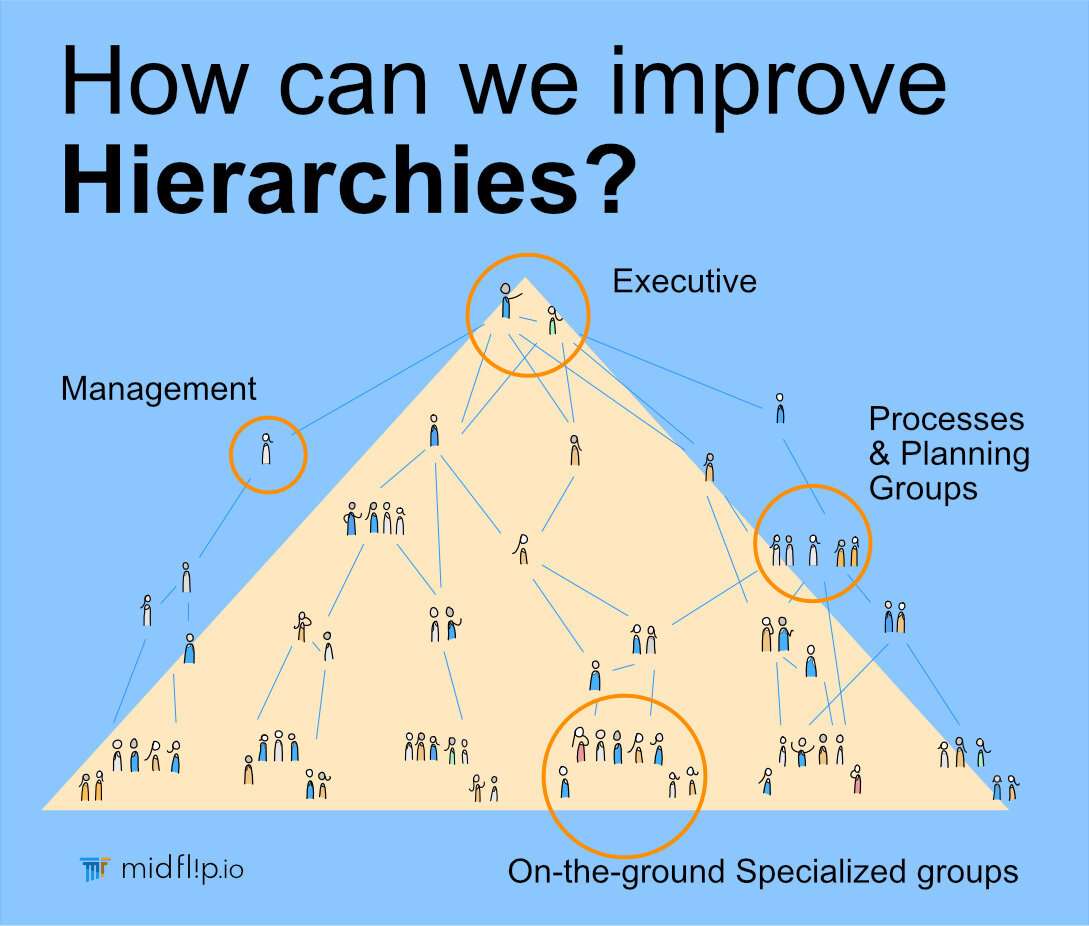
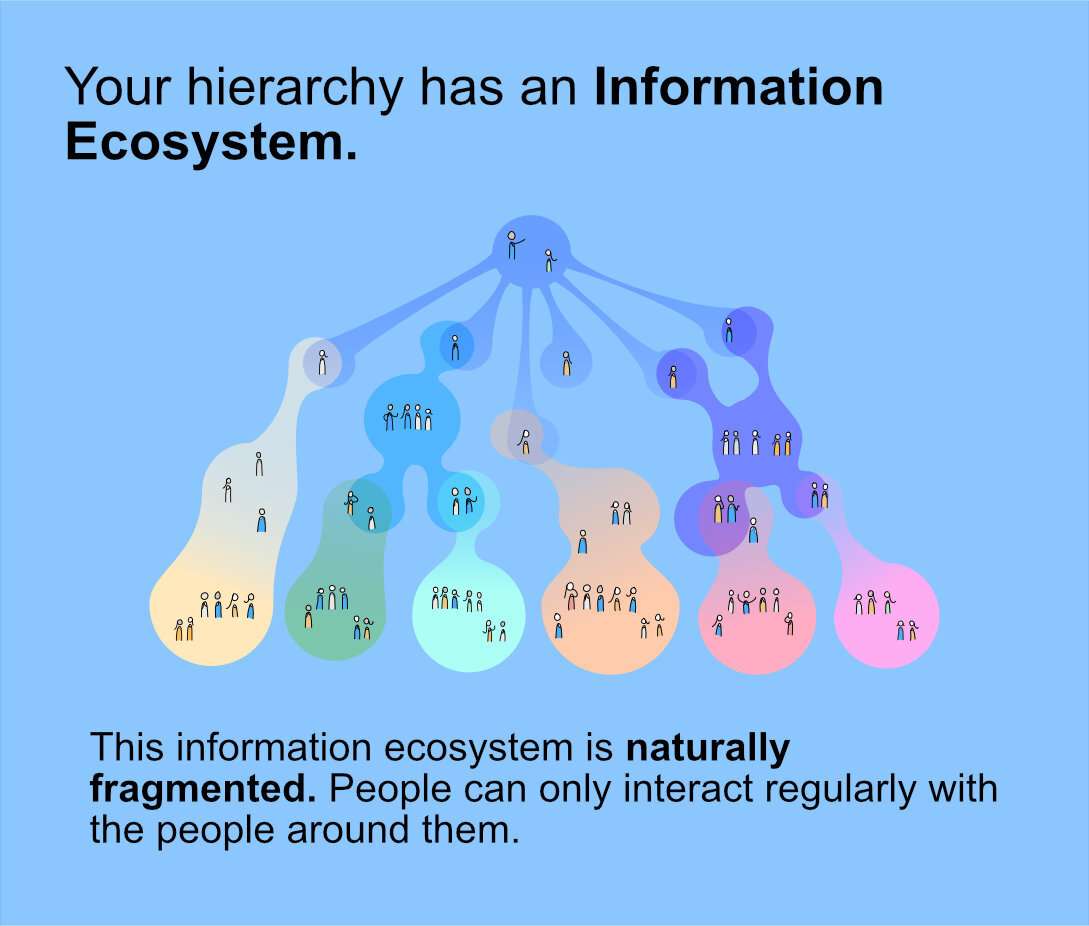
What is an information ecosystem?
People exist within information ecosystems. Networks of communication through which ideas flow from one person to another.
For example, in a workplace, ideas may spread through email chains, team meetings, and water cooler conversations. The collective knowledge shaped by these interactions influence how leaders and employees approach problems and make choices.
Different information ecosystems promote and discourage different types of information. A social media site that limits text length and minimizes moderation is going to be very different from an online encyclopedia that promotes longform content and has overbearing moderation.
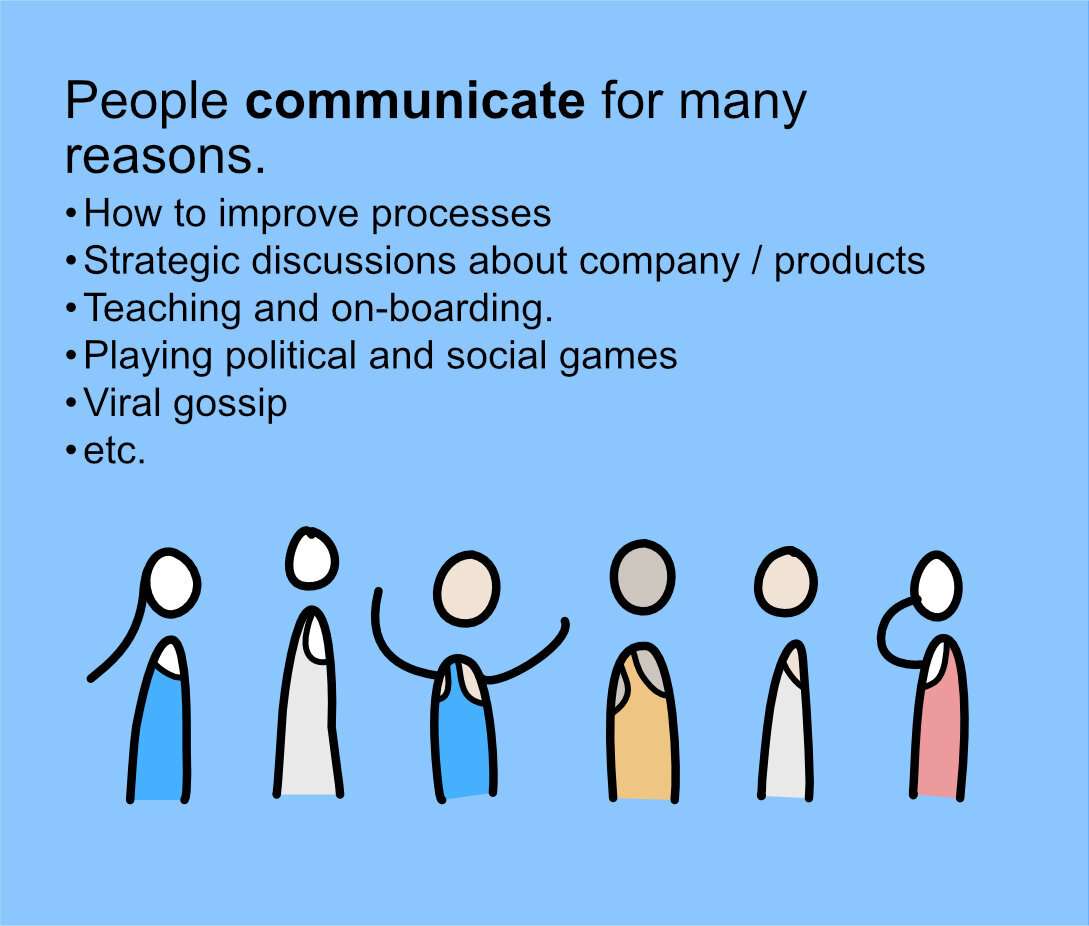
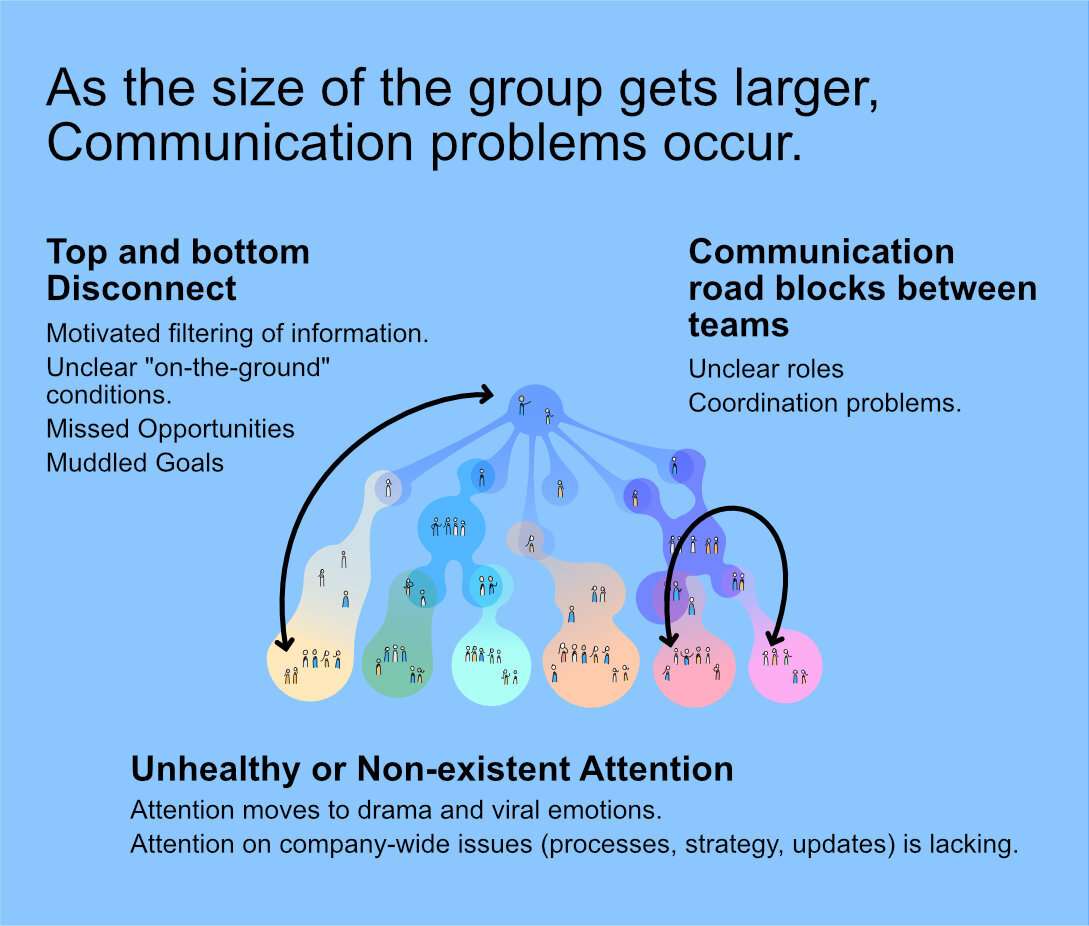
Scaling issues with information ecosystems.
Information ecosystem are the social water we swim through. The information ecosystem determines what we pay attention to, and what decisions are made. Unfortunately, as group size gets bigger, these information systems can become unhealthy and problematic.
The following problems often arise:
Communication Roadblocks Between Teams - Different specializations within companies can have difficulty communicating with other specializations. Effective communication would involve collaborating on many low-down product-level decisions. However this would-be-healthy communication cannot be easily facilitated by managers.
Top and Bottom Disconnect - Good leadership tries to understand the group’s consensus, however they can become isolated. Aggregating group feedback on a variety of issues is hard. Without front-line knowledge of ground conditions, the leadership’s statements can miss the mark, and their decisions can fall flat. Good ideas do not bubble up.
Unhealthy or non-existent Attention. The larger group does not seem to focus on common issues. When there is attention grabbing drama or viral emotions - attention is prevalent. But when discussing processes and procedures… well attention wanes.
And more… Leaders can cause others to fear speaking their mind. Management can filter information for their own personal gain. Individual differences can cause divides etc.
These problems are big problems. Companies lose billions of dollars each year because of these meta, internal communication problems.
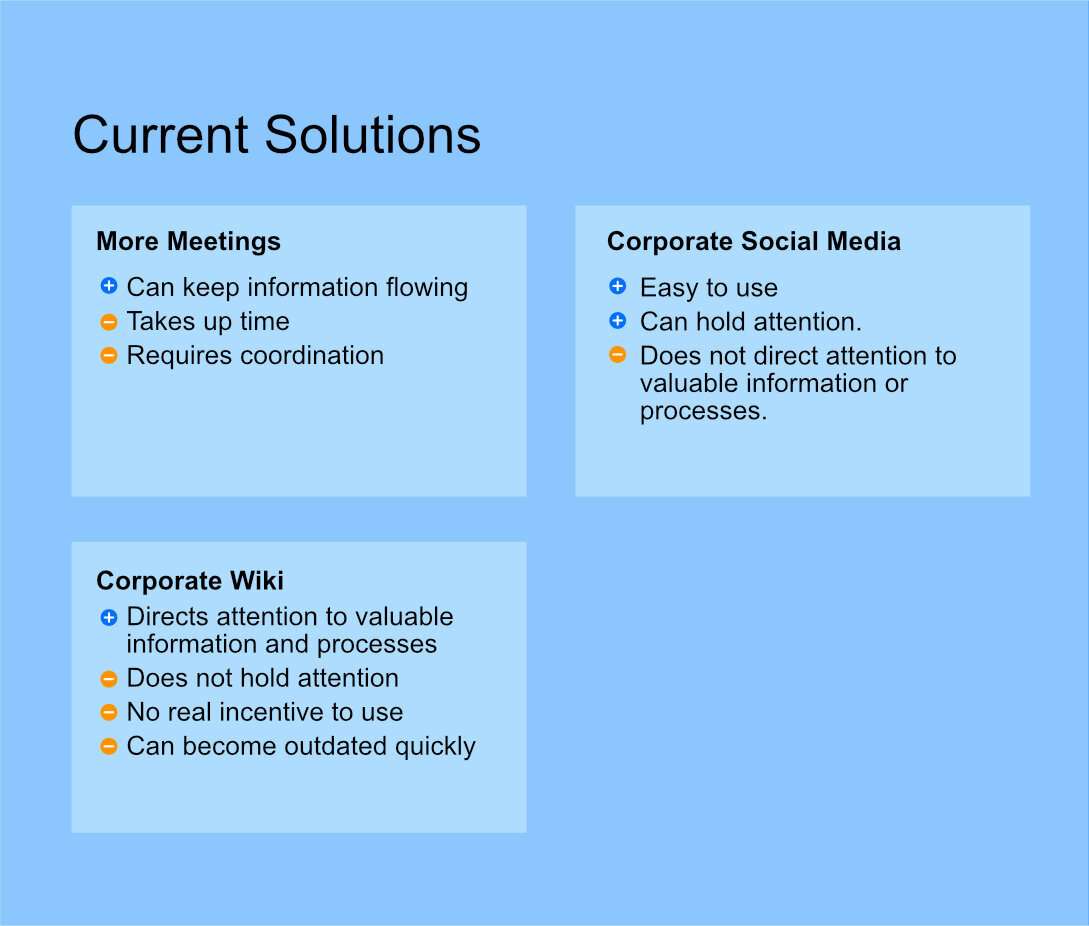
What are the current solutions to communication problems within large organizations?
Communication problems with large hierarchies are well known. Organizations have been dealing with them for a long time. In response a series of “fixes” have been developed.
More Meetings - Yay!!! More meetings can keep information flowing. We can force procedural meetings that makes sure that everyone knows what they need to know. However this takes time and massive coordination. Generally this is more harmful then it is worth.
Social Media Approach - One approach is to create an addictive social media clone, which purports to interconnect the organization with ‘easy’ communication. People use the service because it is simple and attention grabbing. Everyone within the organization is on the service soo… we have solved interdepartmental communication right? Right?
Ahh no. This approach creates a forum without purpose and without structure. The design then encourages short posts… which in turn promotes stale formalities and/or viral content.
Shared Wiki Approach - A second approach is to create a shared wiki. This purports to provide a ground truth resource that people can access and utilize.
Here we have the structure, but we lose the attention. Only a small fraction of the group actively contributes to and maintains the wiki. The content often becomes stale and formulaic, lacking the dynamic, evolving nature of real-world knowledge and discourse. For example, it is rare to find a company wiki where employees are actively debating and discussing "ways to improve x," "changing market conditions," or "comparing and contrasting product a and b.” These wiki’s are a chore, not an interesting social arena.
Generally companies combine these different approaches with limited success.


How Midflip approaches large organization’s communication problems
We are discussing BIG meta problems. Communication Roadblocks Between Teams, Top and Bottom Disconnect, and Unhealthy or non-existent Attention.
To actually take a good stab at these problems we need to rethink our approach.
What do we really want?
We want people to pay attention to the information ecosystem. We want it easy to use.
We want important topics to be presented and accessible.
We want these topics to be updated over time
We want these updates to be collaboratively considered.
We want discussions to bubble the best ideas upward.
We want the topic to represented the groups best understanding and trusted expertise.
We want the information ecosystem to be both structured AND flexible. Coders and designers both need a space to discuss best practices and current projects, but we also need them to interact.
Imagine your company wiki, but stop. Your company wiki is boring. We are going to redesign it so that it feels closer to social media. A system that holds its user's attention is one that gets used. The social media solution does move in the right direction here. Making communication and interaction easy is generally a good thing. For this reason, Midflip incorporates social media feed and interaction.
But it’s not about making it look pretty. It’s about incentives. It’s about giving your employees a reason to learn from this wiki, to update this wiki, to have important conversations within this wiki. For example, we want them to spontaneously discuss topics like “upcoming disruptive technologies” and “Best practices in a meeting”.
So how do we incentivize people within this wiki? Well we make the wiki update process both interesting and meaningful.
Each topic has a king text. This is the best current expression of the topic. To update a topic, someone submits an edit, but it's not immediately accepted. Instead, it appears on the feeds of anyone who have expressed interest or expertise in that topic. For instance, let's say John, a marketing manager, notices that the wiki's content on "Emerging Social Media Trends" is outdated. He submits an edit with the latest information and insights. This edit then appears on the feeds of employees who have expressed interest or expertise in social media marketing. They then can review John's edit… and vote on whether it should replace the current king text.
Indeed, to become the new king text, the edit must win a vote and "knock" the current king off its hill. At Midflip, we're essentially playing the childhood game of king-of-the-hill, but with the goal of best expressing a topic. If John's edit receives more votes, it becomes the new king text for "Emerging Social Media Trends." As the winner, John can now say, "I am the king of the hill when it comes to describing Emerging Social Media Trends!" He has bragging rights.
This is good gamification, but lets be honest, it is still not enough of an incentive. We need something bigger to get people really invested with this wiki.
Furthermore, this system presents an additional challenge: it is unrealistic to expect a dedicated group of individuals to thoroughly review and collaboratively discuss every single update made to the wiki. Even if it were possible to maintain such a high level of interest and participation, the amount of company time required would be substantial.
But don’t worry, we solve these two problems with one stone. We use Liquid Trust Networks.
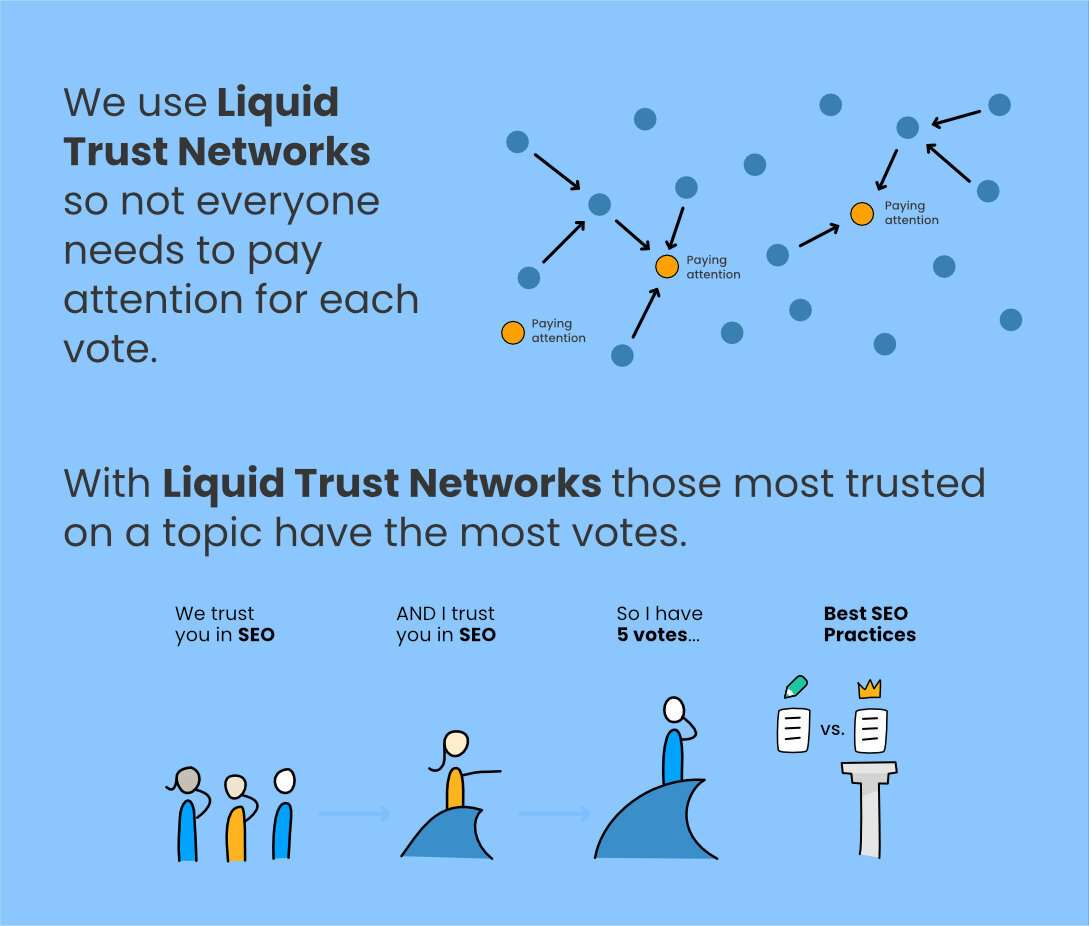
How do Liquid Trust Networks work?
We said earlier that Midflip makes the wiki update process both interesting and meaningful. The update process is interesting because a public vote is called to determine whether the king gets knocked off of its hill - but what makes it meaningful is Liquid Trust Networks.
Liquid Trust Networks allow people to accumulate their colleagues trust within different topics. So that if John trusts Anne within the topic "Upcoming disruptive technologies", then every time Anne votes within that topic, John auto votes too.
Liquid Trust Networks allows employees to delegate their voting power to trusted colleagues within specific topics. This way, those who are most knowledgeable and trusted in a particular area have a greater say in determining the best content for that topic, while still allowing for broader participation and input from the entire organization.
Liquid Trust Networks gives employees real incentive to interact with the system. Now, the company can see who the group thinks is good at x, y, and z. The company can now see which coder has their colleagues trust within the topics “Best coding practices”, “How we should implement feature x”, and “How the tech stack works”. When promotions or bonuses are considered, the company can look into the wiki system and see who has the most trust in which topics. Now THAT is a good incentive.
Consider also the problem of requiring a dedicated group to review every wiki update. Now that is no longer a problem. Trusted individuals within a specific topic can use delegated votes to efficiently manage edits. They can approve valuable contributions and prevent inaccurate changes.
In fact, Liquid Trust Networks is MORE powerful than currently explained. This is because Liquid Trust Networks creates trust chains. If Ron trusts John's expertise, and John trusts Anne, then Anne now wields the voting power of all three individuals within a specific topic. As trust chains grow, a small group of recognized experts can maintain the integrity and quality of a topic without constant input from the entire organization. This approach balances broad participation and efficient decision-making. It ensures the wiki remains up-to-date and accurate while minimizing the burden on the organization as a whole.
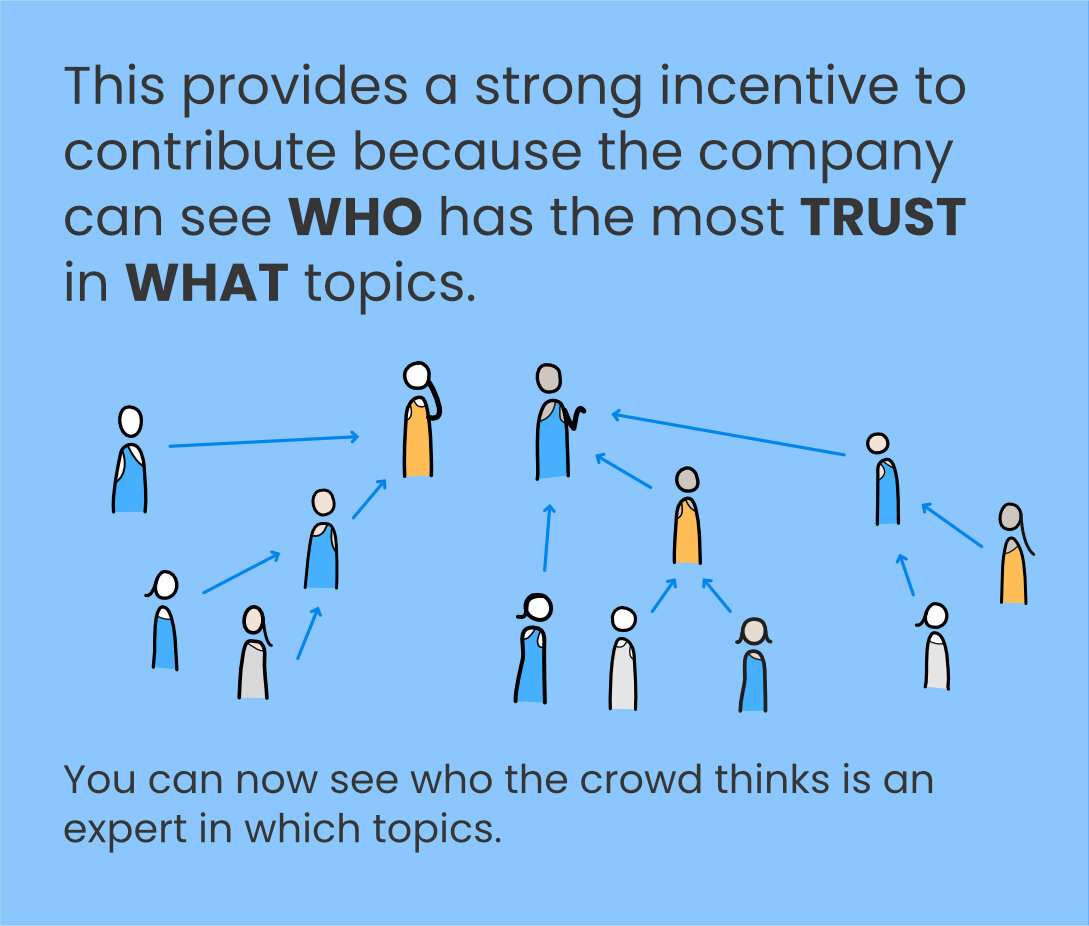
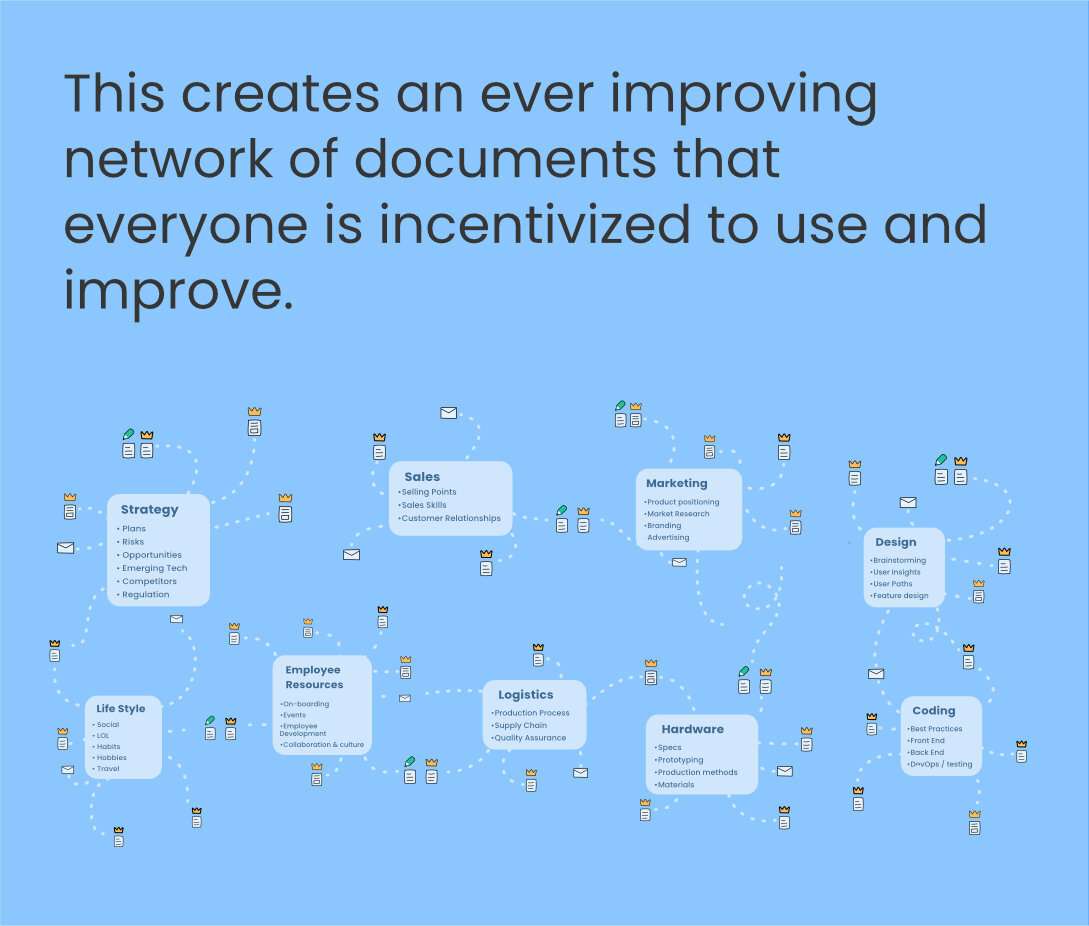

What are the benefits?
Midflip's approach offers several key benefits that directly address common problems faced by large organizations:
Enhanced cross-functional communication: Midflip's platform bridges the gap between different teams and specializations, providing a central hub for designers, coders, and other team members to access and contribute to relevant topics. We are the company watercooler scaled up.
Improved bottom-up feedback: Midflip's gamification and liquid democracy features encourage employees at all levels to participate in shaping the company's collective knowledge. With Midflip, ideas and insights can bubble up, with the best surviving the king-of-the-hill process of refinement. Now valuable perspectives from the front-lines are heard and incorporated into decision-making processes.
Increased employee engagement: By making the wiki update process both interesting and meaningful, Midflip encourages employees to continually improve the group’s understanding. Documents and processes are no longer static and out of date. They are evolving documents that can be improved. They are opportunities to show your worth and get recognized.
Streamlined onboarding: With Midflip, new hires can quickly get up to speed by accessing the company's wiki. They can be assured that they are not reading out of date material, and they can ask questions within the system. The platform also clearly identifies subject matter authorities, making it easier for new employees to find the right people to consult.
Identify hidden talent: Midflip's trust-based system reveals who the group believes is knowledgeable in specific subjects, allowing organizations to make more meritocratic decisions when it comes to promotions, project assignments, and resource allocation. By surfacing hidden talent and expertise, Midflip helps companies optimize their human capital.
In summary, Midflip's innovative approach to internal communication and collaboration directly tackles the most common and costly problems faced by large organizations. By fostering cross-functional collaboration, encouraging bottom-up feedback, maintaining employee engagement, streamlining onboarding, and enhancing talent identification, Midflip helps companies unlock the full potential of their collective knowledge and expertise.
Summary / conclusion
Midflip's innovative approach to internal communication has the potential to revolutionize how large organizations share knowledge and make decisions. By combining gamification, Liquid Trust Networks, and a user-friendly wiki platform, Midflip addresses the core challenges that hinder effective collaboration in big groups. With our system, companies can foster cross-functional communication, encourage bottom-up feedback, increase employee engagement, streamline onboarding, and identify hidden talent.
No, the problem is systematic. It’s the incentives within large companies. It’s the coordination between too many people. It’s the communication games that ensue.
Problems within Information Ecosystems
People exist within information ecosystems. Networks of communication through which ideas flow from one person to another.
For example, in a workplace, ideas may spread through email chains, team meetings, and water cooler conversations. The collective knowledge shaped by these interactions influence how leaders and employees approach problems and make choices.
Different information ecosystems promote and discourage different types of information. A social media site that limits text length and minimizes moderation is going to be very different from an online encyclopedia that promotes longform content and has overbearing moderation.
Information ecosystem are the social water we swim through. The information ecosystem determines what we pay attention to, and what decisions are made. Unfortunately, as group size gets bigger, these information systems can become unhealthy and problematic.
The following problems often arise:
Communication Roadblocks Between Teams - Different specializations within companies can have difficulty communicating with other specializations. Effective communication would involve collaborating on many low-down product-level decisions. However this would-be-healthy communication cannot be easily facilitated by managers.
Top and Bottom Disconnect - Good leadership tries to understand the group’s consensus, however they can become isolated. Aggregating group feedback on a variety of issues is hard. Without front-line knowledge of ground conditions, the leadership’s statements can miss the mark, and their decisions can fall flat. Good ideas do not bubble up.
Unhealthy or non-existent Attention. The larger group does not seem to focus on common issues. When there is attention grabbing drama or viral emotions - attention is prevalent. But when discussing processes and procedures… well attention wanes.
And more… Leaders can cause others to fear speaking their mind. Management can filter information for their own personal gain. Individual differences can cause divides etc.
These problems are big problems. Companies lose billions of dollars each year because of these meta, internal communication problems.
The Current Band-Aids
These communication problems are well known. Organizations have been dealing with them for a long time. In response a series of “fixes” have been developed.
More Meetings - haha
Social Media Approach - One approach is to create an addictive social media clone, which purports to interconnect the organization with ‘easy’ communication. People use the service because it is simple and attention grabbing. Everyone within the organization is on the service soo… we have solved interdepartmental communication right? Right?
Ahh no. This approach creates a forum without purpose and without structure. The design then encourages short posts… which in turn promotes stale formalities and/or viral content.
Shared Wiki Approach - A second approach is to create a shared wiki. This purports to provide a ground truth resource that people can access and utilize.
Here we have the structure, but we lose the attention. Only a small fraction of the group actively contributes to and maintains the wiki. The content often becomes stale and formulaic, lacking the dynamic, evolving nature of real-world knowledge and discourse. For example, it is rare to find a company wiki where employees are actively debating and discussing "ways to improve x," "changing market conditions," or "comparing and contrasting product a and b.” These wiki’s are a chore, not an interesting social arena.
Generally companies combine these different approaches with (very) limited success.
Midflip’s approach
We are discussing BIG meta problems. Communication Roadblocks Between Teams, Top and Bottom Disconnect, and Unhealthy or non-existent Attention.
To actually take a good stab at these problems we need to rethink our approach.
What do we really want?
We want people to pay attention to the information ecosystem. We want it easy to use.
We want important topics to be presented and accessible.
We want these topics to be updated over time
We want these updates to be collaboratively considered.
We want discussions to bubble the best ideas upward.
We want the topic to represented the groups best understanding and trusted expertise.
We want the information ecosystem to be both structured AND flexible. Coders and designers both need a space to discuss best practices and current projects, but we also need them to interact.
Imagine your company wiki, but stop. Your company wiki is boring. We are going to redesign it so that it feels closer to social media. A system that holds its user's attention is one that gets used. The social media solution does move in the right direction here. Making communication and interaction easy is generally a good thing. For this reason, Midflip incorporates social media feed and interaction.
But it’s not about making it look pretty. It’s about incentives. It’s about giving your employees a reason to learn from this wiki, to update this wiki, to have important conversations within this wiki. For example, we want them to spontaneously discuss topics like “upcoming disruptive technologies” and “Best practices in a meeting”.
So how do we incentivize people within this wiki? Well we make the wiki update process both interesting and meaningful.
Each topic has a king text. This is the best current expression of the topic. To update a topic, someone submits an edit, but it's not immediately accepted. Instead, it appears on the feeds of anyone who have expressed interest or expertise in that topic. For instance, let's say John, a marketing manager, notices that the wiki's content on "Emerging Social Media Trends" is outdated. He submits an edit with the latest information and insights. This edit then appears on the feeds of employees who have expressed interest or expertise in social media marketing. They then can review John's edit… and vote on whether it should replace the current king text.
Indeed, to become the new king text, the edit must win a vote and "knock" the current king off its hill. At Midflip, we're essentially playing the childhood game of king-of-the-hill, but with the goal of best expressing a topic. If John's edit receives more votes, it becomes the new king text for "Emerging Social Media Trends." As the winner, John can now say, "I am the king of the hill when it comes to describing Emerging Social Media Trends!" He has bragging rights.
This is good gamification, but lets be honest, it is still not enough of an incentive. We need something bigger to get people really invested with this wiki.
Furthermore, this system presents an additional challenge: it is unrealistic to expect a dedicated group of individuals to thoroughly review and collaboratively discuss every single update made to the wiki. Even if it were possible to maintain such a high level of interest and participation, the amount of company time required would be substantial.
But don’t worry, we solve these two problems with one stone. We use Localized Liquid Democracy.
Localized Liquid Democracy
We said earlier that Midflip makes the wiki update process both interesting and meaningful. The update process is interesting because a public vote is called to determine whether the king gets knocked off of its hill - but what makes it meaningful is localized liquid democracy.
Liquid Democracy allows people to accumulate their colleagues trust within different topics. So that if John trusts Anne within the topic "Upcoming disruptive technologies", then every time Anne votes within that topic, John auto votes too.
Localized liquid democracy allows employees to delegate their voting power to trusted colleagues within specific topics. This way, those who are most knowledgeable and trusted in a particular area have a greater say in determining the best content for that topic, while still allowing for broader participation and input from the entire organization.
Liquid Democracy gives employees real incentive to interact with the system. Now, the company can see who the group thinks is good at x, y, and z. The company can now see which coder has their colleagues trust within the topics “Best coding practices”, “How we should implement feature x”, and “How the tech stack works”. When promotions or bonuses are considered, the company can look into the wiki system and see who has the most trust in which topics. Now THAT is a good incentive.
Consider also the problem of requiring a dedicated group to review every wiki update. Now that is no longer a problem. Trusted individuals within a specific topic can use delegated votes to efficiently manage edits. They can approve valuable contributions and prevent inaccurate changes.
In fact, liquid democracy is MORE powerful than currently explained. This is because liquid democracy creates trust chains. If Ron trusts John's expertise, and John trusts Anne, then Anne now wields the voting power of all three individuals within a specific topic. As trust chains grow, a small group of recognized experts can maintain the integrity and quality of a topic without constant input from the entire organization. This approach balances broad participation and efficient decision-making. It ensures the wiki remains up-to-date and accurate while minimizing the burden on the organization as a whole.
The Benefits
Midflip's approach offers several key benefits that directly address common problems faced by large organizations:
Enhanced cross-functional communication: Midflip's platform bridges the gap between different teams and specializations, providing a central hub for designers, coders, and other team members to access and contribute to relevant topics. We are the company watercooler scaled up.
Improved bottom-up feedback: Midflip's gamification and liquid democracy features encourage employees at all levels to participate in shaping the company's collective knowledge. With Midflip, ideas and insights can bubble up, with the best surviving the king-of-the-hill process of refinement. Now valuable perspectives from the front-lines are heard and incorporated into decision-making processes.
Increased employee engagement: By making the wiki update process both interesting and meaningful, Midflip encourages employees to continually improve the group’s understanding. Documents and processes are no longer static and out of date. They are evolving documents that can be improved. They are opportunities to show your worth and get recognized.
Streamlined onboarding: With Midflip, new hires can quickly get up to speed by accessing the company's wiki. They can be assured that they are not reading out of date material, and they can ask questions within the system. The platform also clearly identifies subject matter authorities, making it easier for new employees to find the right people to consult.
Identify hidden talent: Midflip's trust-based system reveals who the group believes is knowledgeable in specific subjects, allowing organizations to make more meritocratic decisions when it comes to promotions, project assignments, and resource allocation. By surfacing hidden talent and expertise, Midflip helps companies optimize their human capital.
In summary, Midflip's innovative approach to internal communication and collaboration directly tackles the most common and costly problems faced by large organizations. By fostering cross-functional collaboration, encouraging bottom-up feedback, maintaining employee engagement, streamlining onboarding, and enhancing talent identification, Midflip helps companies unlock the full potential of their collective knowledge and expertise.
Conclusion
In conclusion, Midflip's innovative approach to internal communication has the potential to revolutionize how large organizations share knowledge and make decisions. By combining gamification, localized liquid democracy, and a user-friendly wiki platform, Midflip addresses the core challenges that hinder effective collaboration in big groups. With our system, companies can foster cross-functional communication, encourage bottom-up feedback, increase employee engagement, streamline onboarding, and identify hidden talent.



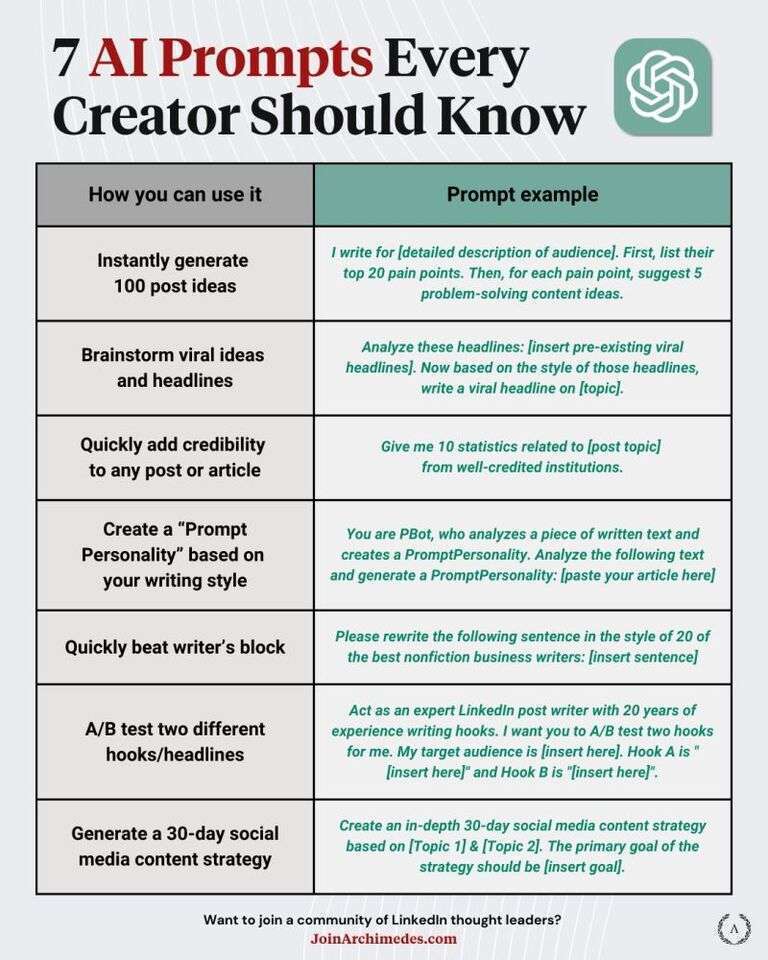
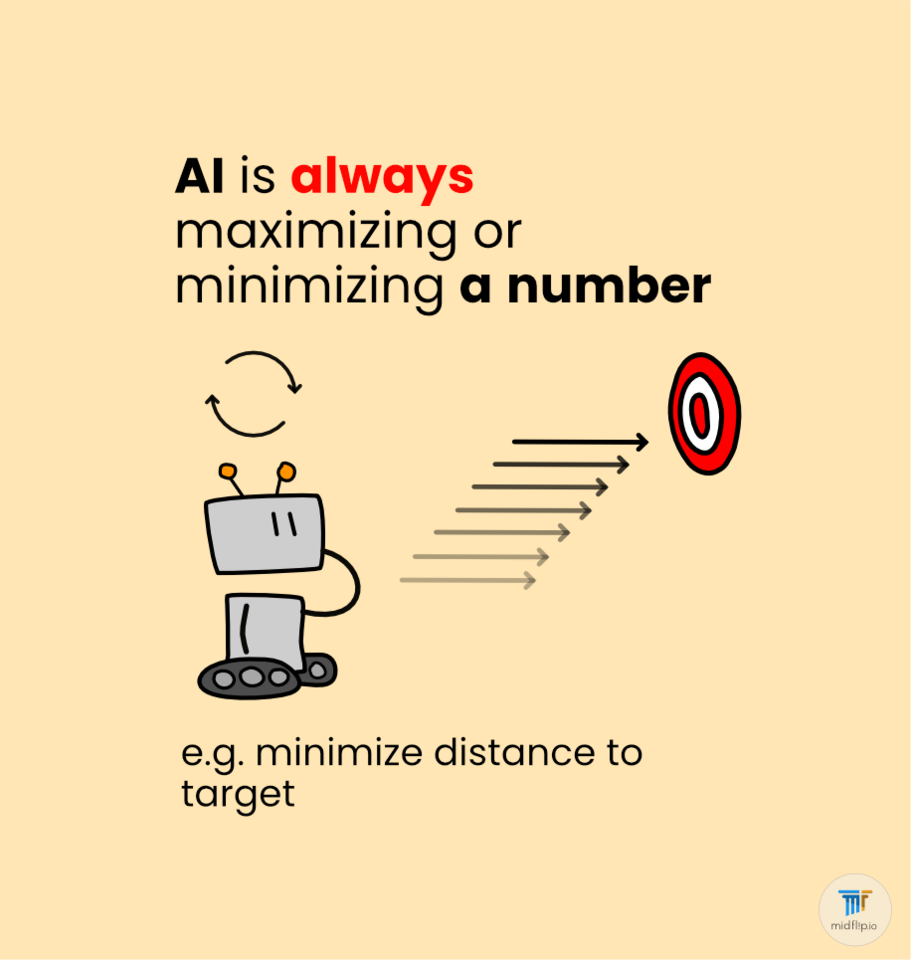
Hot comments
about anything